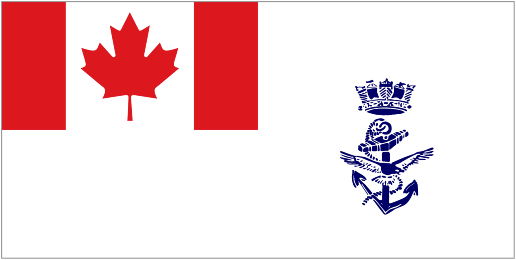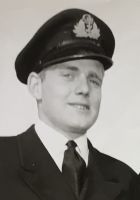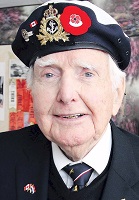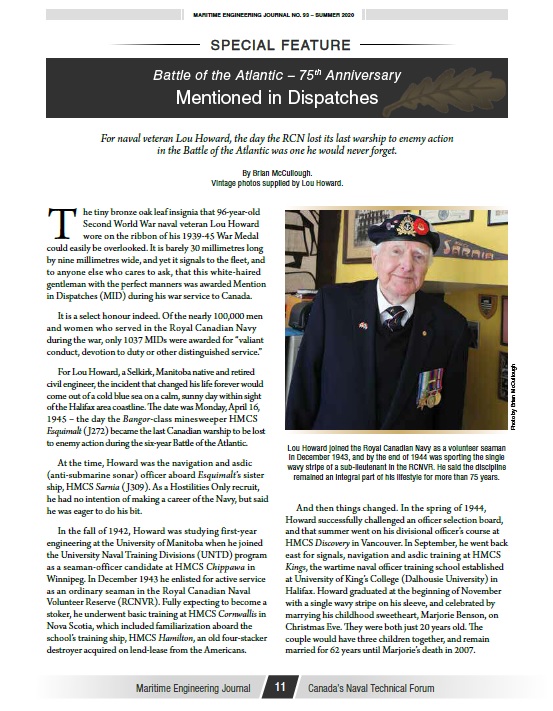|
A Royal Canadian Navy Historical Project
In memory of those who have Crossed the Bar
HOWARD, Louis Henry (Lou) - Louis Henry Howard passed away peacefully on May 4, 2020 at the age of 96, having spent his final days sharing happy moments with family and friends. Lou loved life and lived it to the fullest. He will be remembered for his warmth, sense of humour, love of family and his "sparkle." People were drawn to him by his positive energy and zest for living. Friends and family will be invited to a Celebration of Life to be held at Beechwood Cemetery in Ottawa, to be announced at a later date. (Ottawa Citizen 19 May 2020)
Lou Howard's entry on "the Memory Project" - In first year university, Arts and Science, I joined the UNTD, that’s University Naval Training Division and I did training at Chippawa [Manitoba], which was the Winnipeg Naval Headquarters. And also during the summer I did six weeks out at Naden, which is in Esquimalt, BC and then went out and tried to make some money for the upcoming year. So I decided to go active, and I went active in the navy in December 1942. I went in as an ordinary seaman and somehow, during the training process, I was spotted and asked to sit for an officers’ board and I must have aced the board because before I knew it, I was taken out of a hammock and I was outfitted in probationary officer’s accommodation and I liked that. And I was sent on officer training at King’s College and Cornwallis [Nova Scotia] and other places. But I got out of the lower deck and went up to become the navigating officer and the ASDIC [or Sonar] officer of HMCS Sarnia. We were on convoy duty and I had the pleasure of being frozen to death in the North Atlantic, not frozen to death, but really, really cold in the North Atlantic, shepherding ships in convoys from Halifax. It was called the triangle run. We went from Halifax to south of Iceland which was called West OMP, West Ocean Meeting Place. And then we would pick up ships coming back from England, when we met the mid-Atlantic escort group and we would transfer our ships to them, they would transfer the empties to us and we’d take them back to either New York or Boston or Sydney or someplace or other. And that was our job. A navigating officer keeps track of where the ship is from the time it sails until it gets back again so that they can advise the captain and the helmsman as to where to go, wherever the destination is to be. The moment that an ASDIC contact is made, then the navigator officer, in my case, became the ASDIC officer and I just moved over one position on the bridge and stood behind the ASDIC officer and plotted the various courses that we went on and reported to the captain whether we had a contact and what was happening to the contact. And by keeping track of where the ship had gone when we were chasing an ASDIC contact, then when the ‘all clear’ was signaled, I would then go back and pick up the charts as to where we were when this contact finished and continued being able to advise the captain on what direction and what speeds and where we were supposed to go. So the two jobs worked hand in hand. I was just 21 years old when I did that. We were taken off the Convoy Escort Task Force, and put on local Halifax Defense Force at the end of March 1945, because a submarine had been found outside the gates of Halifax by the interception of communications between the submarine and the headquarters in Germany. So Dockyard said, “There’s a sub out there, so you guys go out on a search and destroy mission.” On April the 14th, 1945, the captain of the [HMCS] Esquimalt came over and we sat in the boardroom, talked about having to sail on the search and destroy mission the next morning. So on April the 15th, we both sailed at 0800, and the Dockyard had given one quadrant to search for the Sarnia and another quadrant out from the Halifax gates, for the Esquimalt to search. We had agreed and we agreed at our meeting in our boardroom on April 14th, 1945, that Sarnia and Esquimalt would meet at a place we called "C buoy". We both knew where it was, but it was a buoy in the water, not too far from the gates, just past the gates of Halifax. And 8:00 on April 16th, 1945, we had agreed we were going to meet. We went out and on April the 16th, 1945, at 8:00, Esquimalt was not to be found. We couldn’t raise her by RT or radio telegraphy. We told the Dockyard, which was Captain D in those days, that Esquimalt had not appeared. And we asked that they send out planes from Shearwater [Nova Scotia] to find out where Esquimalt was. We later learned that Esquimalt had been torpedoed at 0637, on April 16th, 1945. And they’d gone down in about four minutes. The radio operator had no opportunity to send a message or distress and that’s why the Esquimalt did not meet us at 0800 at C buoy on April the 16th, 1945. Between that time, when we sent the message to Halifax Dockyard saying we can’t raise Esquimalt, we got a couple of ASDIC contacts and we were at action stations and dropping depth charges. By 10:30, Dockyard finally woke up and said, “Have you found Esquimalt?” And we said, “No, please send planes out of Shearwater.” At 12:00 noon that day, a plane came over. In those days, I could read the Morse code sent by lamps, and there was a great big airplane flew over and said, “Survivors ahead, survivors ahead.” There we came upon the survivors. We picked up 27 crew members who were alive and 13 crew members who were dead. Forty-four young men died that day in 34 degree temperature water, that’s Fahrenheit, because somebody was not at his job in Halifax on that morning. Yes, albeit it was approaching the end of the war, but you know, we couldn’t do anything about it. But from that action and what I did that day, I was recognized by the government and received a Mention-in-Despatches, which I proudly wear today. We were on patrol, still out at Halifax harbour, still looking for what we thought at that time was the German submarine still lurking around, and that was when the V-E Day riots appeared. They forgot about us out there and I have looked at the log pages and my watch was from 8:00 until noon in the morning and 8:00 until midnight at night. And on June [May] the 6th, we were still out there, they forgot about us because the riots were going on in Halifax and we could see the fires and see the glow from Halifax. And the guy in the RT [radio transmitter] shack, the radio guy, put on Patty Paige singing, "Going to Take a Sentimental Journey." Boy oh boy, you know, all us guys knew that the war was over and we’d come out of it, but they’d forgotten about us and we were out there. So where was I on V-E Day? I was outside, forgotten about. I was on the bridge of HMCS Sarnia, watching the fires, well, seeing the glow in the sky from the fires that were happening in Halifax.
Ships served in: HMCS DISCOVERY - Appointed to Discovery 30 May 1944 as a Prob. SLt, RCNVR (Navy List Jul 1944) HMCS CORNWALLIS - Appointed to Cornwallis 19 Aug 1944 as a Prob. SLt, RCNVR (Navy List Jan 1945) HMCS SARNIA - Appointed Sarnia 07 Jan 1945 as a SLt, RCNVR (seniority 05 Nov 1944) (Navy List Mar 1945 / May 1945)
SLt Lou Howard, RCNVR, M.I.D. Click on the above image to read the full article Maritime Engineering Journal No. 93 - Summer 2020
|
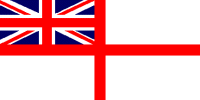 For Posterity's Sake
For Posterity's Sake 